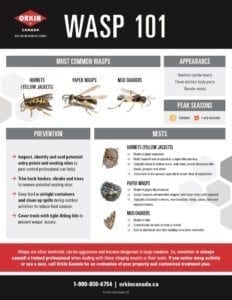Wasps can be territorial and aggressive and become dangerous in large numbers. To help prevent a painful sting, learn how to identify and prevent wasps from taking over your home:
Identifying Wasp Nests
There are many types of wasps, but several common species are more likely to buzz around your property. Each species’ nest is unique and varies by material, shape and location. Be on the lookout for these nests around your home:
- Hornets. Hornets, also known as yellow jackets, often build their nests in hollow trees, wall voids and inside places like sheds, garages and attics.
- Paper Wasps. These tiny pests attach their nests to fences, tree branches, twigs, eaves, doors and window frames.
- Mud daubers. Mud daubers build their homes in sheltered sites. Look for these wasps’ nests in building structures and walls.
Wasp Prevention
Habitat modification is key to keeping wasps from settling down in your space. Remove any potential attractors that may encourage wasp activity to prevent a colony from moving into your property:
- Trim foliage. Bushes, shrubs and trees can all act as potential nesting sites. Keep foliage from overgrowing around your property to discourage wasp activity.
- Identify entry points and nesting sites. Ask Orkin Canada to help inspect your landscaping and building façade to identify potential entry points or nesting sites. Seal up any openings to keep wasps out.
- Eliminate food and spills. Keep any food in an air-tight container and clean up spills immediately to reduce food sources on your property.
- Cover trash. A tight-fitting lid to keep your trash can closed helps prevent wasps from accessing your trash.
If you notice wasp activity or see a nest around your home, contact Orkin Canada before taking matters into your own hands. To learn more about protecting your property against wasps, download our “Wasp 101” guide.
You may also like
Top Pests Expected To Trend In The Summer Of 2023
Warm weather is around the corner, which means pests that have been overwintering or hibernating will wake up as well as non-hibernating pests will start making an appearance outdoors. Being prepared for those spring and summer pests can have an impact on how enjoyable your time will be at home or at work. Using industry leading expertise, we have put together a comprehensive list on the top 8 pests expected to trend in the summer of 2023. This list will provide a deeper dive into the impact that pests can have on your property, along with prevention tips to keep your home or business pest-free.
Top 7 Pests Predicted To Trend In 2022
From mosquitoes and wildlife to ticks and flies, being prepared for spring and summer pests can have an impact on how enjoyable your time outdoors will be. Do not worry you are not alone, as the experienced team at Orkin Canada is there to help you prepare. After doing thorough research, we have put together a comprehensive list on the top 7 pests expected to trend in the summer of 2022. This list will provide an in-depth look at the impact that pests will have on your home or business, along with also providing easy to use preventative tips.
Wasps 101: What Homeowners Need To Know
Wasps can be a real nuisance around your home—especially during the warm months. While these pests are actually rather beneficial for their contributions to agriculture and controlling insect populations, they’re probably not a welcome sight in your backyard. Wasps can ruin outdoor activities and even make their way inside the home to cause even more trouble.
Avoid Painful Pests This Canada Day
Barbeques, fireworks, parades and…bug bites? While each of these activities are perfect for summer celebrations like Canada Day, summertime is also the ideal season for biting and stinging pests to come out in full force. Identifying which of these pests might make an appearance in your backyard can help you take the steps necessary to protect your home – and potential party guests – from their painful bites.
Remove pests from your business, and stop them from coming back
We work hard to listen, understand and assess your unique situation. Request a free, no-obligation consultation today for a customized pest program that fits your needs.
Request a Free Business ConsultationRequest a Free Home Estimate


